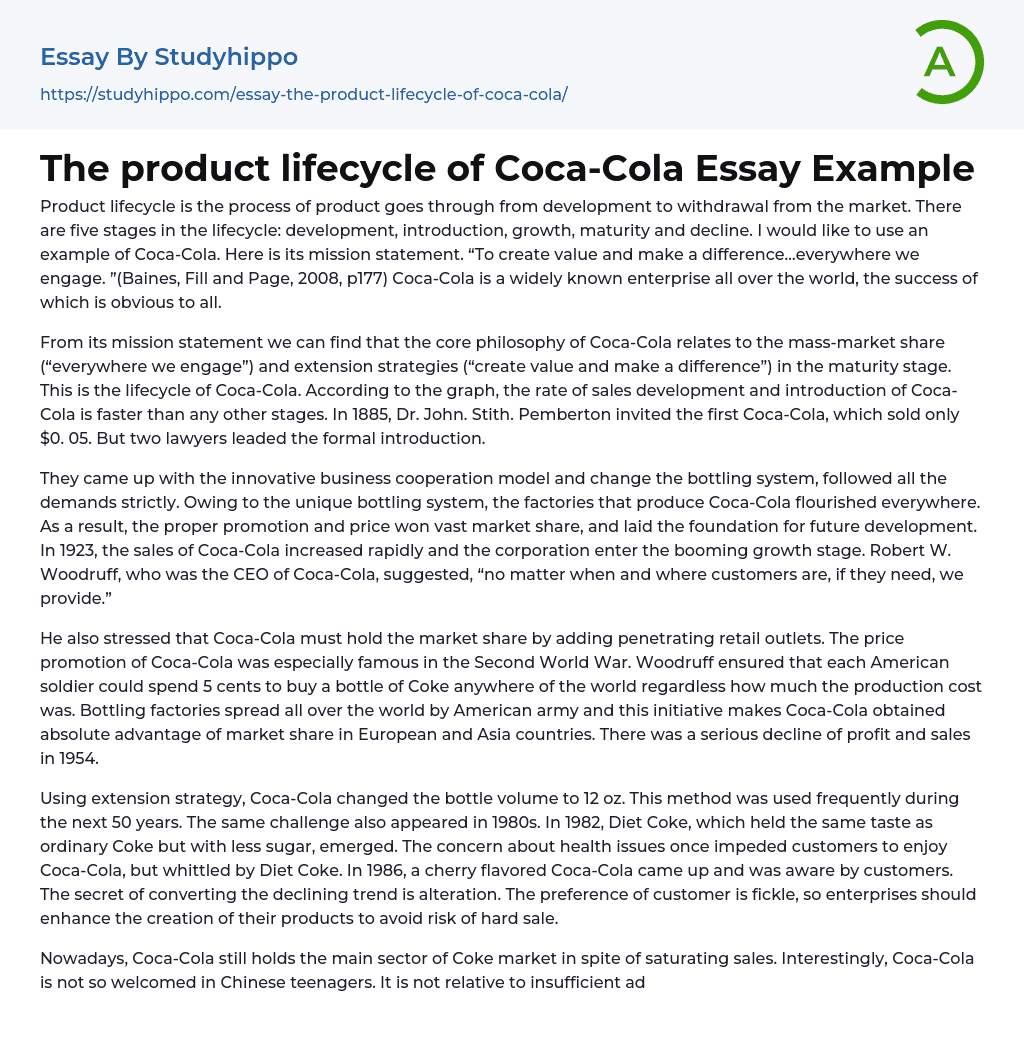Product lifecycle is the process of product goes through from development to withdrawal from the market. There are five stages in the lifecycle: development, introduction, growth, maturity and decline. I would like to use an example of Coca-Cola. Here is its mission statement. “To create value and make a difference…everywhere we engage. ”(Baines, Fill and Page, 2008, p177) Coca-Cola is a widely known enterprise all over the world, the success of which is obvious to all.
From its mission statement we can find that the core philosophy of Coca-Cola relates to the mass-market share (“everywhere we engage”) and extension strategies (“create value and make a difference”) in the maturity stage. This is the lifecycle of Coca-Cola. According to the graph, the rate of sales development and introduction of Coca-Cola is faster than any other stages. In
...1885, Dr. John. Stith. Pemberton invited the first Coca-Cola, which sold only $0. 05. But two lawyers leaded the formal introduction.
They came up with the innovative business cooperation model and change the bottling system, followed all the demands strictly. Owing to the unique bottling system, the factories that produce Coca-Cola flourished everywhere. As a result, the proper promotion and price won vast market share, and laid the foundation for future development. In 1923, the sales of Coca-Cola increased rapidly and the corporation enter the booming growth stage. Robert W. Woodruff, who was the CEO of Coca-Cola, suggested, “no matter when and where customers are, if they need, we provide.”
He also stressed that Coca-Cola must hold the market share by adding penetrating retail outlets. The price promotion of Coca-Cola was especially famous in
the Second World War. Woodruff ensured that each American soldier could spend 5 cents to buy a bottle of Coke anywhere of the world regardless how much the production cost was. Bottling factories spread all over the world by American army and this initiative makes Coca-Cola obtained absolute advantage of market share in European and Asia countries. There was a serious decline of profit and sales in 1954.
Using extension strategy, Coca-Cola changed the bottle volume to 12 oz. This method was used frequently during the next 50 years. The same challenge also appeared in 1980s. In 1982, Diet Coke, which held the same taste as ordinary Coke but with less sugar, emerged. The concern about health issues once impeded customers to enjoy Coca-Cola, but whittled by Diet Coke. In 1986, a cherry flavored Coca-Cola came up and was aware by customers. The secret of converting the declining trend is alteration. The preference of customer is fickle, so enterprises should enhance the creation of their products to avoid risk of hard sale.
Nowadays, Coca-Cola still holds the main sector of Coke market in spite of saturating sales. Interestingly, Coca-Cola is not so welcomed in Chinese teenagers. It is not relative to insufficient advertising and promotion in Chinese market, but caused by the massive domestic drink industries, which fitly illustrates how does the competition imperils the market share of an enterprise. In conclusion, the product lifecycle demonstrates the entire tendency of a firm or a specific industry. It helps firms to act properly to fit the market (customer demand).
- Chief Executive Officer essays
- Convenience Store essays
- Firm essays
- Training And Development essays
- Unilever essays
- Variable Cost essays
- Virgin Group essays
- Bargaining essays
- Entity essays
- Pest analysis essays
- John Locke essays
- 9/11 essays
- A Good Teacher essays
- A Healthy Diet essays
- A Modest Proposal essays
- A&P essays
- Academic Achievement essays
- Achievement essays
- Achieving goals essays
- Admission essays
- Advantages And Disadvantages Of Internet essays
- Alcoholic drinks essays
- Ammonia essays
- Analytical essays
- Ancient Olympic Games essays
- APA essays
- Arabian Peninsula essays
- Argument essays
- Argumentative essays
- Art essays
- Atlantic Ocean essays
- Auto-ethnography essays
- Autobiography essays
- Ballad essays
- Batman essays
- Binge Eating essays
- Black Power Movement essays
- Blogger essays
- Body Mass Index essays
- Book I Want a Wife essays
- Boycott essays
- Breastfeeding essays
- Bulimia Nervosa essays
- Business essays
- Business Process essays
- Canterbury essays
- Carbonate essays
- Catalina de Erauso essays
- Cause and Effect essays
- Cesar Chavez essays




